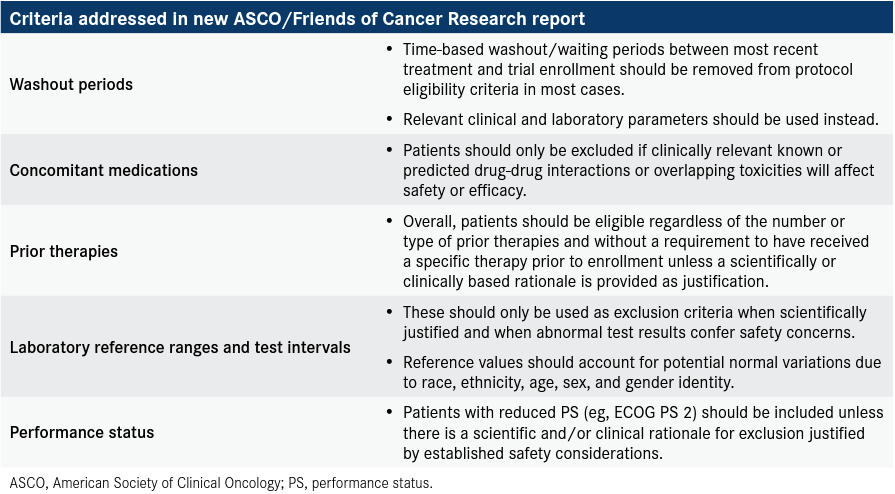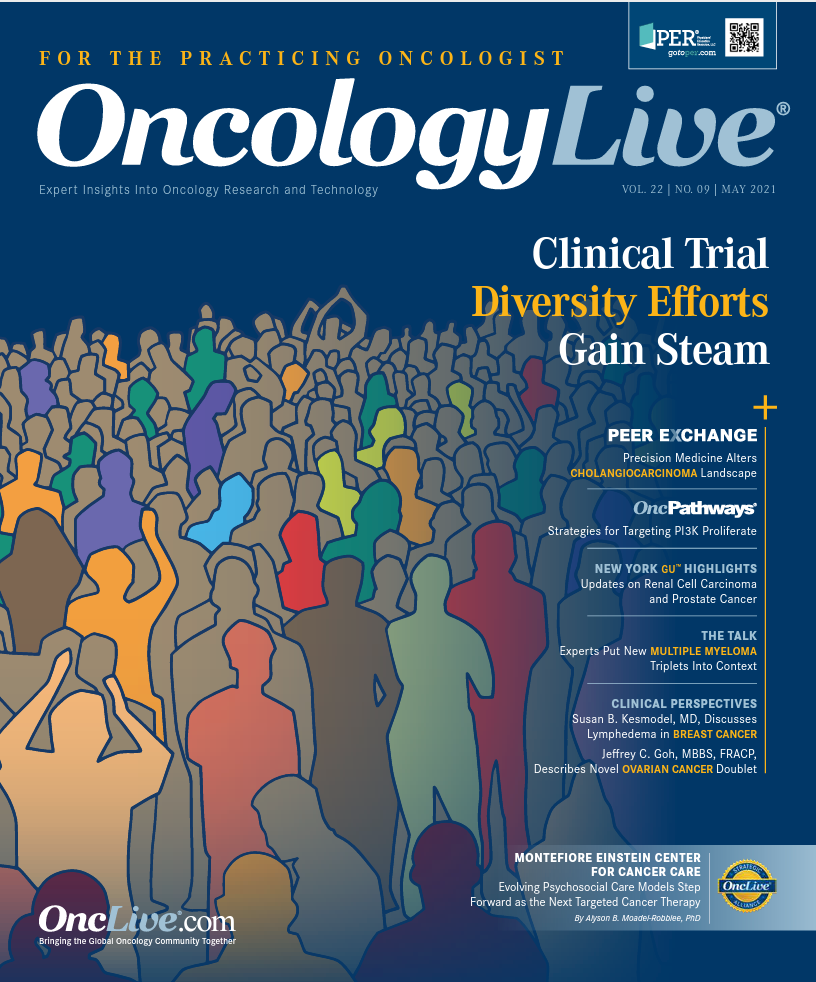Publication
Article
Clinical Trial Diversity Efforts Gain Steam
Author(s):
Nearly 30 years after National Institutes of Health sought to increase participation of minorities in clinical trials, a demographic imbalance remains.
Kimlin Tam Ashing, PhD

In 1993, the National Institutes of Health (NIH) Revitalization Act mandated that women and members of racial and ethnic minorities be recruited for all NIH-sponsored clinical trials, with enough participants in subpopulations, particularly in phase 3 studies, to assess any valid differences in outcomes. Investigators seeking NIH grants were required to conduct outreach programs to help ensure that those goals were met.1
But when it comes to minorities with cancer, the law has failed to deliver on its promise. Nearly 30 years after NIH sought to increase participation of minorities in clinical trials, a demographic imbalance remains. Of 4922 patients who participated in clinical trials that led to approvals for 18 new oncology drugs during 2020, 73% were White, 14% were Asian, 6% were Hispanic, and 5% were Black or African American, according to the FDA (Figure).2
Figure. 2020 Clinical Trials Snapshot for New Oncology Drugs2

During the past year, however, the COVID19 pandemic has shined a new light on health care disparities while racial justice protests have added an element of intensity to the discussions, experts say. A recent spate of developments illustrates fresh momentum for broadening access to clinical trials—and cancer care overall—for Black and Hispanic patients as well as other populations with lagging participation. These developments include the following:
- A “road map” for designing multiple myeloma (MM) clinical trials that include more African American patients has been advanced by investigators from the Dana-Farber Cancer Institute in Boston, Massachusetts, in collaboration with experts from the FDA and the American Association for Cancer Research (AACR).3 The plan follows study findings that show the number of African American individuals enrolled in select MM trials declined by 3.5% from 2002 to 2011, even though incidence and mortality rates for the malignancy are higher than they are for White patients.4
- A massive COVID-19 relief and government funding package that Congress passed in December 2020 will require state Medicaid programs to cover routine patient costs for participation in qualifying clinical trials, including for cancer indications, starting in 2022. The lack of Medicaid coverage has impeded recruitment of minorities and the poor.5
- In September 2020, AACR released its first comprehensive report, which describes health care inequities and serves as a call to action for patients with cancer, including expanding clinical trial enrollment among minorities.6
- New models for improving access to clinical trials for minorities include hospital partnerships with community centers and clinical practices to treat patients in the areas where they live to increase clinical trial participation.
In interviews with OncLive®, leading oncology experts say that the convergence of efforts represents progress for racial minorities and that, they believe, this time there will be no turning back.
“I think it’s changed,” said Kimlin Tam Ashing, PhD, founding director of the Center of Community Alliance for Research and Education and professor in the Department of Population Sciences at City of Hope Medical Center in Duarte, California. “I think it’s multiple factors, particularly the Black Lives Matter movement and COVID-19. I think the whole country, the whole world has come to a deeper consciousness-raising and the sense that we have to do something. We cannot ignore this and say this is somebody else’s responsibility.”
COVID-19 Highlights Problems
The death toll from COVID-19 in the United States has surpassed the 570,000 mark, but the disproportionate impact on minorities is pronounced. The risk of COVID-19 hospitalization and death is 2.8 and 1.9 times higher, respectively, for Black or African American non-Hispanic individuals than it is for White individuals and 3.0 and 2.3 times higher, respectively, for Hispanic or Latino persons. “Race and ethnicity are risk markers for other underlying conditions that affect health, including socioeconomic status, access to health care, and exposure to the virus related to occupation, eg, frontline, essential, and critical infrastructure workers,” according to the CDC.7
Such statistics cast renewed attention on disparities in cancer care. Overall, progress has been made in narrowing the gap in the cancer death rate, which was 33% higher in 1990 for African American vs White individuals to 14% higher in 2016, according to the AACR report; but much work remains to be done.6 The risk of dying from prostate cancer is 111% higher for African American men than it is for White men, and African American women have a 39% higher risk of dying from breast cancer than White women. Also, when it comes to leukemia, Hispanic children and adolescents are 20% and 38% more likely to develop the disease, respectively, than White children and adolescents.6
The task of making clinical trial populations more inclusive is complicated by a variety of factors, including trial availability, restrictive eligibility criteria, and the logistics of taking time off from work, the AACR report noted.6
Moreover, concerns about inclusion of racial minorities in clinical trials are played out against a backdrop of broader issues about the gap between study populations and real-world patients with cancer. One study found that enrollment in a clinical trial for first-line therapy markedly favors patients who are younger and have fewer comorbidities than the population of patients with cancer as a whole, as well as those with private insurance, and those who obtain treatment at academic medical centers.8
In some respects, the disparities in clinical trial enrollment are a result of business pressures that drive pharmaceutical companies to test novel drugs in homogenous populations with fewer confounding factors at high-enrolling sites.9
Additionally, the increasingly global nature of oncology drug development may worsen the minority enrollment gap in the United States, investigators found. In a study of patient enrollment in 49 global trials supporting 35 FDA drug approvals from 2015 through 2018 with race data available, Black patients made up only 2.5% of participants (range, 0%-10%). In 21 trials with both race and accrual location data available, 64% of patients were from outside the United States.10
New Model for MM Research
One of the more concrete proposals aimed at improving racial imbalances in clinical trials is getting underway in the MM research community as leading investigators seek to extend the benefits of novel treatments to underrepresented populations.
“We’ve had a paradigm shift and a marked improvement in outcomes of patients due to the development of multiple novel treatments,” Kenneth C. Anderson, MD, a 2014 Giants of Cancer Care® award winner in the myeloma category, said in an inter-view. “It turns out not all patients have shared equally in the progress.”
Kenneth C. Anderson, MD

Compared with White individuals, African American persons are more than twice as likely to receive a diagnosis of MM (15.9 vs 7.5 cases per 100,000 population) and to die from the disease (5.6 vs 2.4 myeloma deaths per 100,000). From 1973 to 2005, the 5-year relative survival rate increased from 26.3% to 35.0% for White Americans, a statistically significant improvement (P < .005), compared with an increase from 31.0% to 34.1% for African American people. An analysis of 9 large MM trials conducted by National Cancer Institute cooperative groups showed that enrollment of African American participants declined to 13% during 2002 to 2011 from 16.5% in the prior decade.4
Findings from other studies show that a more racially diverse trial population may yield a different outcome. For example, patients with MM of high African ancestry are more likely than those with high European background to harbor immunoglobulin heavy-chain translocations on chromosome 14, specifically t(11;14) and the high-risk t(14;16) or t(14;20) abnormalities.4
This could have therapeutic implications for patients. In the phase 3 BELLINI trial (NCT02755597), the benefit of adding venetoclax (Venclexta) vs placebo to bortezomib (Velcade) and dexamethasone in patients with relapsed or refractory MM was observed only in those participants with t(11;14) and high BCL2 expression.11
Anderson, who is studying venetoclax in patients with MM and t(11;14), sees the biomarker-driven emphasis as a noteworthy implication of more diverse clinical trial populations. “That’s a major opportunity to carry out clinical trials of this novel agent that are solely or certainly enriched by African American patients,” said Anderson, the Kraft Family Professor of Medicine at Harvard Medical School and director of the Jerome Lipper Multiple Myeloma Center and LeBow Institute for Myeloma Therapeutics at Dana-Farber Cancer Institute.
New recommendations to make MM trials more racially inclusive grew out of a workshop involving Anderson, who heads the AACR’s regulatory science and policy subcommittee, and FDA officials.
Before clinical trials are approved, sponsors should consider expanding cohorts with broader eligibility criteria, drafting a specific diversity study plan, appointing a diversity officer for phase 2 and 3 studies, and designing trials that cover disease subtypes and features most commonly seen in African American individuals.4
The plan, which also includes postapproval recommendations, could be applied to other groups and diseases, investigators noted. “Indeed, it is the hope of everyone who contributed to this initiative that these recommendations will lead to a more inclusive, ‘real world’ drug development paradigm,” the authors wrote.4
Diversity Affects Findings
Underrepresentation of minorities in clinical trials comes at the cost of not knowing whether treatment effectiveness and adverse effects are the same for their populations as for White patients. For instance, the patient’s immune status is believed to have an impact on the efficacy of immunotherapy. However, a recent analysis showed that the percentage of Black or African American patients ranged from 0% to 4% in clinical trials that led to approvals of immune checkpoint inhibitors involving 6 cancer types.9
Additionally, disparities for minority participation have significant overlap with imbalances for other subgroups. In a study of outcomes for 41,109 patients who participated in large phase 2 and phase 3 trials from 1985 to 2012, participants from areas with the highest socioeconomic deprivation had worse outcomes compared with those from the most affluent areas for overall survival (HR, 1.28, 95% CI, 1.20- to 1.37; P < .001), progression-free survival (HR, 1.20; 95% CI, 1.13-1.28; P < .001), and cancer-specific survival (HR, 1.27; 95% CI, 1.18-1.37; P < .001).12
Such findings illustrate why it was so critical for legislation requiring Medicaid to cover routine costs for patients participating in clinical trials, said Karen Winkfield, MD, PhD, who recently was named executive director of the Meharry-Vanderbilt Alliance, a strategic partnership between Meharry Medical College, a historically Black institution, and Vanderbilt University Medical Center, both in Nashville, Tennessee.
Karen Winkfield, MD, PhD

“This is not just race-ethnicity,” Winkfield said in an interview. “This is poor people, rural people.”
The AACR report used contributions from experts throughout the oncologic f ield to propose a blueprint for addressing health disparities. Among the recommendations were improving minority representation in clinical trial enrollment—including reduction of certain restrictive eligibility criteria—improving screening and early detection of cancers, conducting diversity- focused training and career development programs, and increasing diversity within the clinician pool.6
Years of underrepresentation of African American and Hispanic participants in clinical trials has taken a cumulative toll as far as lack of data on how they might be affected by certain treatments. A 2009 analysis found that, despite the requirements of the NIH Revitalization Act of 1993, racial and ethnic groups were scarcely represented in genomic studies: 96% were carried out in populations of European descent. Although samples in the proportion of genome-wide association studies from underrepresented populations had risen to 19% when the issue was revisited in 2016, most of the increase was from Asian ancestry samples, with other ethnic groups experiencing minimal increase (from 1% to 4%).13
“There’s so much we need to learn in this area,” said Edith A. Perez, MD, the 2014 Giants of Cancer Care® award winner in the community outreach category, the Serene M. and Frances C. Durling Professor of Medicine at Mayo Clinic College of Medicine in Jacksonville, Florida, and vice chair of the Alliance for Clinical Trials in Oncology. “But the good thing is that the increased discussion in this topic is directly translating into action like I don’t remember seeing in the past.”
Broadening eligibility criteria overall is another key strategy to improve participation of minorities in clinical trials. In February, the American Society of Clinical Oncology (ASCO) and Friends of Cancer Research issued new recommendations in 5 specific areas: treatment washout periods, concomitant medications, prior therapies, laboratory reference ranges and test intervals, and patient performance status (Table14). The groups’ previous effort to expand trial eligibility resulted in the FDA revising its guidance for patients with brain metastases, minimum age for enrollment, HIV status, organ dysfunction, and prior or concurrent malignancies.14
Table. Recommendations for Expanding Clinical Trial Eligibility14

“Clinical trial access must be recognized as a health equity issue,” Lori J. Pierce, MD, FASTRO, FASCO, a professor and vice provost for academic and faculty affairs at the University of Michigan who is president of ASCO, said in announcing the new recommendations. “Overly restrictive eligibility criteria without scientific justification has led to an underrepresentation of older adults, racial/ ethnic and sexual/gender minorities, and patients with well-managed comorbidities.”14
More focus should be placed on needlessly excluding patients due to comorbidities, Perez said. “Patients are being excluded for various reasons, including age, because it’s associated with comorbidities and concern about their impact and safety,” she said. “But we’ve learned those factors are really irrelevant.”
Some Centers Report Change
A paper published last year in Contemporary Clinical Trials Communications by Jeanne M. Regnante, chief health equity and diversity officer at the LUNGevity Foundation in Bethesda, Maryland, and colleagues illustrates a path forward on improving diversity.
Fourteen leaders representing 8 cancer centers were asked how they achieved accrual rates for racial and ethnic minority groups of 10% to 50% in a 12-month reporting period. Among the findings were metrics for collection and reporting, routinely captured race and ethnicity data that are accessible to staff, and operational standards to support access and inclusion.15
“I think when it becomes part of your standard practice, you don’t overthink,” Winkfield said. “You don’t say, ‘Oh, this is a Black person, and it’s going to be harder and they’re going to have issues.’ Or if you have a Spanish-speaking person, you don’t say, ‘Oh, it’s going to really tough. We’ve got to go get a translator.’”
The percentages of African American and Hispanic participants in trials for COVID-19 vaccines have been much more representative of the actual population, Winkfield noted. Outreach is critical to the African American community partly because of the Tuskegee Study of Untreated Syphilis in the Negro Male, in which hundreds of Black men were not given penicillin for the infection as part of a study even after it was established as a cure. The study continued for 40 years before being halted in 1972.16
According to the CDC, Pfizer/BioNTech and Moderna, Inc had approximately 10% Black representation in their trials and 26.2% and 20.0% Hispanic representation, respectively. As of 2019, according to the US Census Bureau, 12.3% and 17.6% of the population 16 years and older were Black persons and Hispanic persons, respectively.17
Ashing said clinicians’ frame of reference on Black patients’ reticence to participate in trials also needs to change. “Much of the literature from media and scientific literature describes this as medical mistrust,” she said. “I refrain from that terminology because I believe it is victim blaming. I prefer to frame it in terms of adaptive caution and concern because of our history of medical abuse.”
Some hospitals are taking innovative steps to reach out to the community, Ashing noted. City of Hope is developing partnerships with community clinics and hospitals as well as through their 29 community practices. These practices were developed in areas with high minority density and high numbers of underserved patients with cancer to provide access for prevention, screening, and studies and clinical trials. The use of telemedicine, brought about by the pandemic, may make significant inroads as well, she said.
Winkfield said the recruitment of racial and ethnic minorities to oncology teams is crucial. Patients feel more comfortable with doctors who look like them, she said. “What I usually get from Black patients is, ‘Oh my God, I can’t believe you’re a Black doctor.’ It’s different. There’s an instant rapport. I may be the first Black doctor they’ve ever seen.”
When White oncologists are not culturally aware and respectful enough of minority patients, the results can be tragic, Winkfield said. She described the case of a 28-year-old Black nurse with triple-negative breast cancer, the incidence of which is disproportionately higher in African American women. Winkfield advised her to undergo chemotherapy first and then surgery and radiation.
At their next visit, the woman explained to Winkfield that she had stopped the chemotherapy due to adverse effects and had gone straight to surgery. Winkfield said the oncologist, who was a White physician, dismissed the woman’s concerns rather than prescribe medication for the adverse effects and agreed to let her halt chemotherapy instead of insisting she stay the course.
Winkfield directed the woman back to chemotherapy, but it was too late. “I can’t say it was a direct result of the fact that she [went months without] chemotherapy, but that young woman ended up dying of brain metastases at age 29,” Winkfield said. “Those sorts of stories should never happen.”
References
- NIH guidelines on the inclusion of women and minorities as subjects in clinical research. National Institutes of Health. NIH Guide. 1994;23(11):34. Accessed April 19, 2021. https://bit.ly/3ajgpdS
- FDA. 2020 drug trials snapshots summary report. February 2021. Accessed April 19, 2021. https://bit.ly/3svWqyX
- New recommendations aim to eliminate racial bias in myeloma trials. News release. Dana-Farber Cancer Institute. February 17, 2021. Accessed April 19, 2021. https://bit.ly/3v2DnxY
- Gormley N, Fashoyin-Aje L, Locke T, et al. Recommendations on eliminating racial disparities in multiple myeloma therapies: a step toward achieving equity in healthcare. Blood Cancer Discov. 2021;2(2):119-124. doi:10.1158/2643-3230.BCD-20-0123
- Barker T. Coverage of routine clinical trial costs under the Medicaid program. Foley Hoag LLP Medicaid + The Law blog. January 15, 2021. Accessed April 19, 2021. https://bit.ly/3v7xZtt
- American Association for Cancer Research. Cancer Disparities Progress Report. September 16, 2020. Accessed April 19, 2021. https://bit.ly/2REcVfs
- Risk for COVID-19 infection, hospitalization, and death by race/ethnicity. CDC. Updated April 16, 2021. Accessed April 19, 2021. https://bit.ly/32r0qGv
- Zaorsky NG, Zhang Y, Walter V, Tchelebi LT, Chinchilli VM, Gusani NJ. Clinical trial accrual at initial course of therapy for cancer and its impact on survival. J Natl Compr Canc Netw. 2019;17(11):1309-1316. doi:10.6004/jnccn.2019.7321
- Nazah B, Mishra M, Pentz R, Owonikoko TK. Enrollment of racial minorities in clinical trials: old problem assumes new urgency in the age of immunotherapy. Am Soc Clin Oncol Educ Book. 2019;39:3-10. doi:10.1200/EDBK_100021
- Tharakan S, Zhong X, Galsky MD. The impact of the globalization of cancer clinical trials on the enrollment of Black patients. Cancer. Published online March 8, 2021. doi:10.1002/cncr.33463
- Kumar SK, Harrison SJ, Cavo M, et al. Venetoclax or placebo in combination with bortezomib and dexamethasone in patients with relapsed or refractory multiple myeloma (BELLINI): a randomised, double-blind, multicentre, phase 3 trial. Lancet Oncol. 2020;21(12):1630-1642. doi:10.1016/S1470-2045(20)30525-8
- Unger JM, Moseley AB, Cheung CK, et al. Persistent disparity: socioeconomic deprivation and cancer outcomes in patients treated in clinical trials. J Clin Oncol. 2021;39(12):1339-1348. doi:10.1200/JCO.20.02602
- Bentley AR, Callier S, Rotimi CN. Diversity and inclusion in genomic research: why the uneven progress? J Community Genet. 2017;8(4):255-266. doi:10.1007%2Fs12687-017-0316-6
- ASCO and Friends of Cancer Research recommend expanding patient access to cancer clinical trials by further broadening eligibility criteria. News release. American Society of Clinical Oncology. February 9, 2021. Accessed March 17, 2021. https://bit.ly/2QenJk4
- Regnante JM, Richie N, Fashoyin-Aje L, et al. Operational strategies in US cancer centers of excellence that support the successful accrual of racial and ethnic minorities in clinical trials. Contemp Clin Trials Commun. 2020;17:100532. doi:10.1016/j.conctc.2020.100532
- About the USPHS syphilis study. Tuskegee University. Accessed April 19, 2021. http://bit.ly/3tysh3P
- Artiga S, Kates J, Michaud J, Hill L. Racial diversity within COVID-19 vaccine clinical trials: key questions and answers. Kaiser Family Foundation. January 26, 2021. Accessed April 19, 2021. https://bit.ly/32xA3OQ









